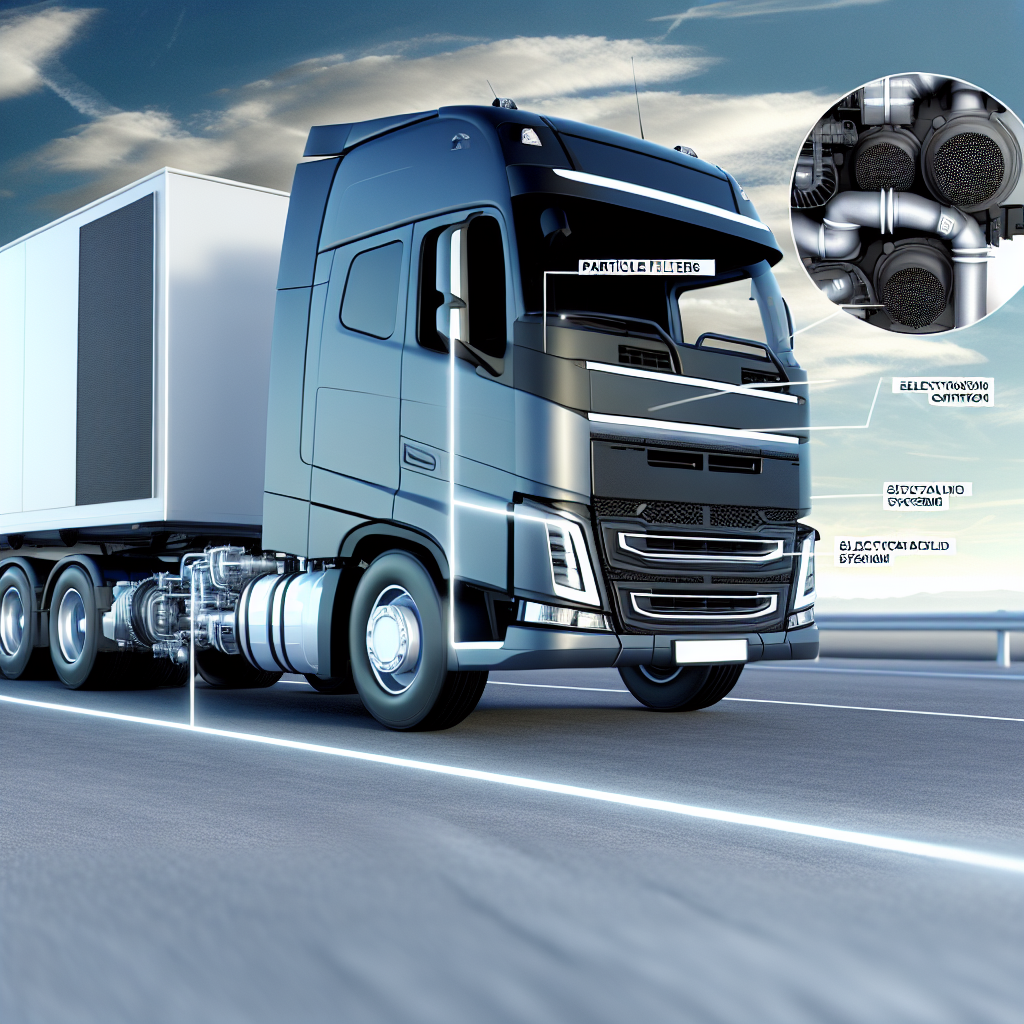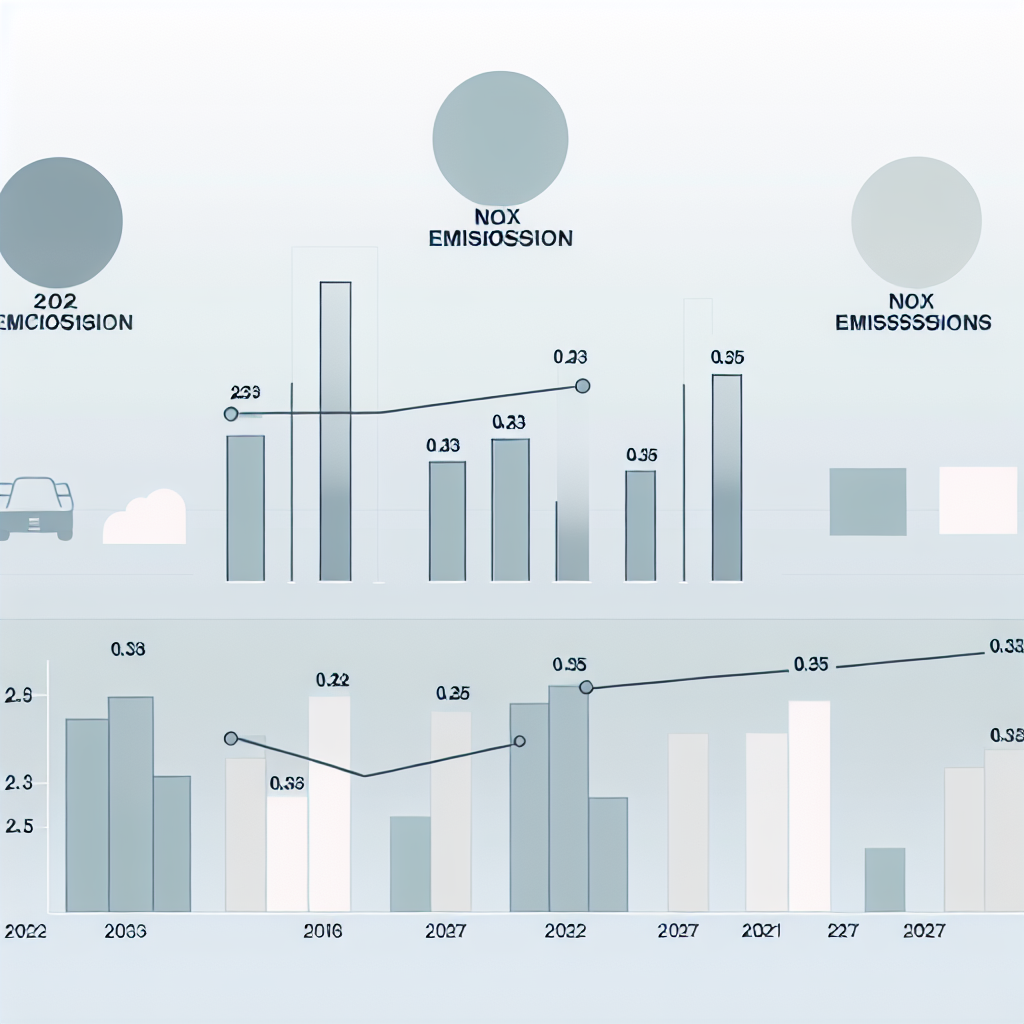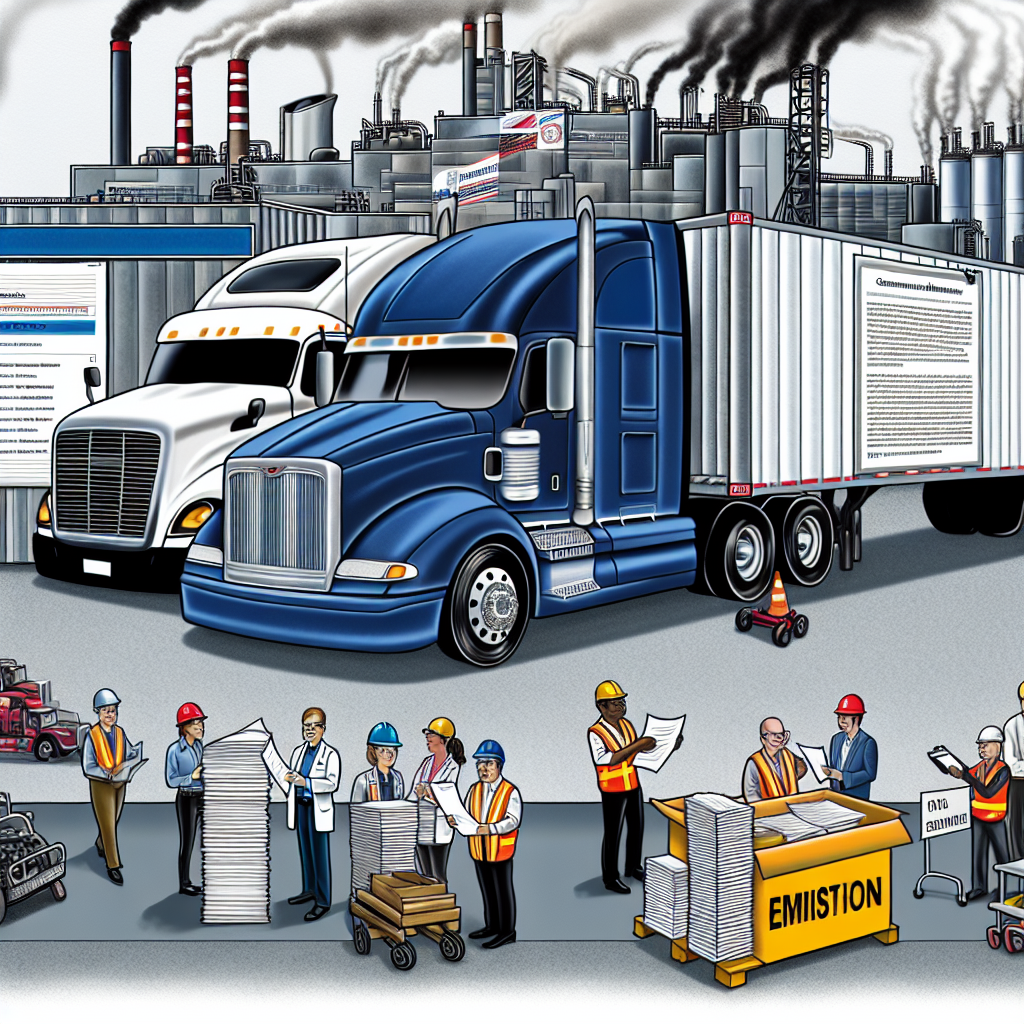As the trucking industry prepares for upcoming emissions regulations, the significance of the newly imposed NOx standards cannot be overstated. These regulations, set to mandate a drastic reduction of NOx emissions from 0.2 grams to a stringent 0.035 grams by 2027, present a formidable challenge for original equipment manufacturers (OEMs). The Environmental Protection Agency (EPA) estimates that these new standards will result in reducing up to one billion tons of greenhouse gas emissions over the next 30 years, translating to approximately $13 billion in net benefits due to improved public health outcomes.
Furthermore, nearly 45% of fleets have begun implementing sustainability programs, showcasing their proactive steps towards compliance. However, there is also an anticipated 12% increase in the cost of new diesel trucks, underscoring the necessity for robust compliance strategies as OEMs navigate this complex regulatory landscape. With the increased scrutiny on emissions compliance, the implications are profound not only for powertrains being launched but also for future warranty provisions for emission control technologies.
OEMs are expressing growing concerns about the clarity and consistency of compliance standards across borders, particularly between the U.S. and Canada. This careful consideration underscores the necessity for a well-thought-out strategy for compliance, as any missteps could lead to significant repercussions, both operationally and financially.
Industry leaders like Sean Waters have emphasized that evolving these vehicles to meet the upcoming standards is one of the most critical undertakings in recent years. As we delve deeper into these regulations and their impact, it is imperative for stakeholders to acknowledge the looming changes and the responsible approaches needed to adapt to the future of trucking under stringent emissions regulations.

NOx Reduction Requirements
As part of the ongoing efforts to combat air pollution and promote sustainability in the transportation sector, significant changes are on the horizon regarding nitrogen oxides (NOx) emissions. By 2027, regulations are set to require a drastic reduction of NOx emissions from the current limit of 0.2 grams per brake horsepower hour to an unprecedented 0.035 grams. This represents an 83% decrease and aligns with national policies aimed at improving air quality and public health.
The implications of these regulatory changes are vast and varied across the industry. With over 4 million vehicles crossing the Canada-U.S. border, the harmonization of emissions standards has become essential for OEMs operating in both markets. These new requirements not only push manufacturers to enhance their technology significantly but also compel them to invest in compliance strategies that include extensive research and development.
According to industry leaders like Sean Waters, the urgency of adapting to the 2027 NOx standards cannot be understated, as OEMs have been preparing for these changes for several years now. Companies such as Daimler Truck North America and Cummins are at the forefront, innovating and refining their engines to meet stringent emissions regulations. The transition to these new standards, while necessary for environmental compliance, poses challenges such as increased costs of technologies and potential disruptions in supply chains.
Moreover, the impact on warranty provisions for emission control technologies will play a critical role in how these companies mitigate risks associated with the new regulations. The advancements in emission control systems, while expected to be more efficient, will also demand rigorous testing and assurance measures to maintain compliance over the lifecycle of the vehicles.
This proactive approach towards compliance will help OEMs adapt to evolving regulations and reinforce their commitment to sustainable practices. However, the transition period will require close attention to detail and a willingness to innovate continuously. The impending deadlines set forth by regulatory bodies highlight the need for an agile and responsive industry capable of meeting the expectations for a greener future in trucking.
The Role of Warranty Provisions in Emissions Compliance
Warranty provisions play a crucial part in how original equipment manufacturers (OEMs) navigate the complexities of emissions regulations. With significant changes looming on the horizon, particularly regarding nitrogen oxides (NOx) emissions, OEMs must rethink their warranty strategies to mitigate costs and maintain compliance under stringent new standards.
These provisions are not merely a backstop for manufacturers; they can actively influence compliance strategies by promoting an environment of accountability and incentivizing adherence to regulations. By extending warranty coverage on emission control technologies, OEMs can assure customers of the reliability of their investments, which in turn enhances brand trust and customer loyalty.
Furthermore, robust warranty provisions can help offset the increased costs associated with developing advanced emission control technologies. As manufacturers invest in innovative solutions to comply with regulations—such as improved catalytic converters and enhanced exhaust systems—warranty programs can safeguard both manufacturers and customers from potential financial pitfalls should these technologies fail prematurely. This financial cushion encourages OEMs to adopt cutting-edge technologies while reassuring fleet operators that they are making sound investments.
Additionally, warranty strategies can be nuanced to include provisions that specifically cover emissions-related components and performance. By doing so, OEMs can create a feedback loop that fosters continuous improvement of their technologies, allowing for the collection of valuable data on component performance over time. This information can be pivotal in further refining these technologies and ensuring compliance with evolving regulations.
Ultimately, the strategic incorporation of warranty provisions allows OEMs to approach emissions compliance not just as a regulatory obligation, but as a competitive advantage in a rapidly changing market. As the industry moves towards more stringent environmental standards, the emphasis on comprehensive warranty programs will likely intensify, shaping how manufacturers plan for compliance and manage costs effectively. In this challenging regulatory climate, the role of warranty provisions cannot be understated, as they will be essential in guiding OEMs through the complexities of emissions regulations while reinforcing their commitment to environmental sustainability.
In conclusion, OEMs that deliberately integrate strong warranty strategies into their compliance frameworks will not only safeguard their investments but also support their ecological responsibilities. The evolving landscape of emissions regulations demands innovative thinking and proactive measures, and warranty provisions will serve as a critical tool in achieving both financial and environmental goals.
With the upcoming emissions regulations posing significant challenges for truck manufacturers, industry experts have weighed in on the crucial role that warranty provisions can play in compliance strategies.
Paul Rosa, senior vice-president of procurement and fleet planning at Penske, noted, “The upcoming emissions standards create a foggy road ahead for fleets. They need clear guidance in navigating the changes, which makes warranty provisions a vital aspect of ensuring confidence in compliance and technology reliability.”
Sean Waters, vice-president of product compliance at Daimler Truck North America, emphasized the infrastructure challenges related to meeting emissions standards, stating, “Achieving compliance hinges not only on technological advancements but also on the readiness of charging and fueling infrastructure. This is where well-designed warranty provisions will help. They provide fleets with the assurance they need as they transition to more complex and costly technologies necessary to meet these regulations.”
These insights underline that as OEMs adapt to stringent emissions standards, robust warranty strategies will not only support operational continuity but also foster trust and commitment to sustainable practices in the industry.
Comparison of OEM Approaches to Warranty Provisions
| Company | Warranty Strategy | Compliance Focus | Key Technologies |
|---|---|---|---|
| Daimler Truck North America | Focuses on comprehensive warranty coverage for emission control technologies. | Achieving 2027 NOx standards through innovation. | Advanced catalytic converters, improved exhaust systems. |
| Cummins | Implements extended warranty periods for emissions-related components. | Ensuring reliability and performance under regulations. | Diesel and alternative fuel engines. |
| Penske Truck Leasing | Emphasizes clear guidance and support for fleets navigating emissions standards. | Facilitating fleet compliance with evolving regulations. | Fleet management solutions, alternative energy systems. |
| North American Council for Freight Efficiency | Advocates for best practices in warranty provisions to promote compliance. | Industry-wide collaboration on emissions technologies. | Freight efficiency technologies, eco-friendly initiatives. |
This table summarizes the various strategies employed by notable OEMs in the trucking industry regarding warranty provisions, crucial in navigating emissions regulations effectively. Each company has adopted specific approaches to ensure compliance and performance while addressing the costs and operational challenges posed by the new standards.
Perspectives of Different Stakeholders on Emissions Regulations
The trucking industry encompasses a wide range of stakeholders who express varying perspectives on emissions regulations and warranty provisions. Original Equipment Manufacturers (OEMs), fleet operators, regulators, and environmental groups all play crucial roles in shaping the dialogue around these pivotal changes.
OEMs Perspective
OEMs are at the forefront of adapting technologies to meet stringent emissions regulations, particularly the upcoming NOx standards. Their primary concern centers on the clarity and consistency of these regulations, especially given the cross-border complexities between the U.S. and Canada. For industry leaders like Daimler Truck North America, the focus is two-fold: achieving compliance and ensuring that their products remain economically viable.
Manufacturers are also concerned about the potential costs associated with compliance. Developing new technologies to meet the 2027 NOx emissions limit necessitates significant investment. As these companies innovate, they look to warranty provisions as vital components of their strategy. By extending warranties on emissions-related technology, OEMs can mitigate financial risks and reassure fleet operators about the reliability of their investment.
Fleet Operators’ Perspective
From the perspective of fleet operators, emissions regulations might appear as hurdles, but they also present opportunities for improved operational efficiency and reduced environmental impact. However, the costs associated with upgrading to compliant vehicles can be substantial. These operators depend heavily on OEM warranties to ensure that they are protected against potential failures of advanced emission control technologies, which could become increasingly complex.
Furthermore, consistent and transparent communication from OEMs about warranty coverage and compliance is critical. Fleet operators like Penske emphasize that clear guidance can foster confidence in transitioning to newer technologies that meet emissions standards. This shift not only complies with regulations but also aligns with the growing societal demand for greener business practices.
Environmental Groups Perspective
Environmental advocates are largely supportive of strict emissions regulations as they represent vital steps toward mitigating climate change and improving air quality. They encourage companies to adopt sustainable practices and technologies, advocating for a swift transition to zero-emission vehicles. They view warranty provisions as essential tools that can incentivize OEMs to innovate and enhance the reliability of emission control technologies, thereby promoting accountability in the industry.
Benefits for the Industry
Adopting robust emissions regulations, while challenging, is beneficial for the trucking industry as a whole. It prompts OEMs to invest in research and develop cleaner technologies. This drive for innovation can lead to enhanced product offerings and operational efficiencies for fleets. Furthermore, strong warranty provisions can elevate customer trust and ensure a more sustainable approach to emissions management. Ultimately, collaboration among stakeholders will be crucial for navigating these changes and achieving a greener future in trucking.

Conclusion: A Call to Embrace the Emotional Weight of Compliance
As we reach the conclusion of our exploration into the stringent emissions regulations facing the trucking industry, it becomes apparent that the emotional burden of compliance pressures weighs heavily on both original equipment manufacturers (OEMs) and fleet operators. The shift to dramatically lower NOx emissions standards, from 0.2 grams to 0.035 grams by 2027, is not merely a technical challenge but a profound responsibility that impacts livelihoods, the environment, and public health.
OEMs, with their pivotal role, feel the weight of heightened expectations as they strive to innovate and adapt. The fear of falling short in meeting these regulations can create anxiety that permeates every decision, fueling urgency in R&D and compliance strategies. The stakes are felt beyond the bottom line, as OEMs recognize their impact on community well-being and environmental sustainability. Each technical advancement not only signifies progress but symbolizes a commitment to a healthier planet and the livelihoods tied to it.
Conversely, fleet operators grapple with the emotional strain of transitioning to compliant technologies amidst rising costs and potential disruptions. The pressure to maintain operational efficiency while adhering to new regulations can invoke feelings of uncertainty and trepidation. As they rely on OEM warranties to mitigate risks associated with advanced emission control technologies, the conversation shifts from transactional to relational. Trust and mutual support become paramount as stakeholders navigate this challenging landscape together.
In embracing the emotional dimensions of compliance pressures, OEMs and fleet operators can foster a culture of collaboration and innovation. Working hand-in-hand, they can transform the inherent difficulties of navigating emissions regulations into a renewed sense of purpose—collectively striving towards a more sustainable future while prioritizing the well-being of their employees, communities, and the environment. This emotional commitment to compliance echoes far beyond immediate implications—it resonates in the legacy they build for generations to come, shaping the future of the trucking industry and its role in environmental stewardship.
As the trucking industry prepares for upcoming emissions regulations, the significance of the newly imposed NOx standards cannot be overstated. Set to mandate a drastic reduction of NOx emissions from 0.2 grams to a stringent 0.035 grams by 2027, these regulations present a formidable challenge for original equipment manufacturers (OEMs). With the increased scrutiny on emissions compliance, the implications are profound not only for powertrains being launched but also for future warranty provisions for emission control technologies. OEMs are expressing growing concerns about the clarity and consistency of compliance standards across borders, particularly between the U.S. and Canada, as they navigate this regulatory landscape. This careful consideration underscores the necessity for a well-thought-out strategy for compliance with emissions regulations, as any missteps could lead to significant repercussions, both operationally and financially. Industry leaders like Sean Waters have emphasized that evolving these vehicles to meet the upcoming standards is one of the most critical undertakings in recent years. As we delve deeper into these regulations and their impact, it is imperative for stakeholders to acknowledge the looming changes and the responsible approaches needed to adapt to the future of trucking under stringent emissions regulations.

NOx Reduction Requirements
As part of the ongoing efforts to combat air pollution and promote sustainability in the transportation sector, significant changes are on the horizon regarding nitrogen oxides (NOx) emissions. By 2027, emissions regulations are set to require a drastic reduction of NOx emissions from the current limit of 0.2 grams per brake horsepower hour to an unprecedented 0.035 grams. This represents an 83% decrease and aligns with national policies aiming to improve air quality and public health.
The implications of these regulatory changes are vast and varied across the industry. With over 4 million vehicles crossing the Canada-U.S. border, the harmonization of emissions standards has become essential for OEMs operating in both markets. These new requirements not only push manufacturers to enhance their technology significantly but also compel them to invest in compliance strategies that include extensive research and development.
According to industry leaders like Sean Waters, the urgency of adapting to the 2027 NOx standards cannot be understated, as OEMs have been preparing for these changes for several years now. Companies such as Daimler Truck North America and Cummins are at the forefront, innovating and refining their engines to meet stringent emissions regulations. The transition to these new standards, while necessary for environmental compliance, poses challenges such as increased costs of technologies and potential disruptions in supply chains.
Moreover, the impact on warranty provisions for emission control technologies will play a critical role in how these companies mitigate risks associated with the new regulations. The advancements in emission control systems, while expected to be more efficient, will also demand rigorous testing and assurance measures to maintain compliance over the lifecycle of the vehicles.
This proactive approach towards compliance will help OEMs adapt to evolving emissions regulations and reinforce their commitment to sustainable practices. However, the transition period will require close attention to detail and a willingness to innovate continuously. The impending deadlines set forth by regulatory bodies highlight the need for an agile and responsive industry capable of meeting the expectations for a greener future in trucking.
The Role of Warranty Provisions in Emissions Compliance
Warranty provisions play a crucial part in how OEMs navigate the complexities of emissions regulations. With significant changes looming on the horizon, particularly regarding nitrogen oxides (NOx) emissions, OEMs must rethink their warranty strategies to mitigate costs and maintain compliance under stringent new standards.
These provisions are not merely a backstop for manufacturers; they can actively influence compliance strategies by promoting an environment of accountability and incentivizing adherence to regulations. By extending warranty coverage on emission control technologies, OEMs can assure customers of the reliability of their investments, which in turn enhances brand trust and customer loyalty.
Furthermore, robust warranty provisions can help offset the increased costs associated with developing advanced emission control technologies. As manufacturers invest in innovative solutions to comply with regulations—such as improved catalytic converters and enhanced exhaust systems—warranty programs can safeguard both manufacturers and customers from potential financial pitfalls should these technologies fail prematurely. This financial cushion encourages OEMs to adopt cutting-edge technologies while reassuring fleet operators that they are making sound investments.
Additionally, warranty strategies can be nuanced to include provisions that specifically cover emissions-related components and performance. By doing so, OEMs can create a feedback loop that fosters continuous improvement of their technologies, allowing for the collection of valuable data on component performance over time. This information can be pivotal in further refining these technologies and ensuring compliance with evolving emissions regulations.
Ultimately, the strategic incorporation of warranty provisions allows OEMs to approach emissions compliance not just as a regulatory obligation, but as a competitive advantage in a rapidly changing market. As the industry moves towards more stringent environmental standards, the emphasis on comprehensive warranty programs will likely intensify, shaping how manufacturers plan for compliance and manage costs effectively. In this challenging regulatory climate, the role of warranty provisions cannot be understated, as they will be essential in guiding OEMs through the complexities of emissions regulations while reinforcing their commitment to environmental sustainability.
In conclusion, OEMs that deliberately integrate strong warranty strategies into their compliance frameworks will not only safeguard their investments but also support their ecological responsibilities. The evolving landscape of emissions regulations demands innovative thinking and proactive measures, and warranty provisions will serve as a critical tool in achieving both financial and environmental goals.
With the upcoming emissions regulations posing significant challenges for truck manufacturers, industry experts have weighed in on the crucial role that warranty provisions can play in compliance strategies. Paul Rosa, senior vice-president of procurement and fleet planning at Penske, noted, “The upcoming emissions standards create a foggy road ahead for fleets. They need clear guidance in navigating the changes, which makes warranty provisions a vital aspect of ensuring confidence in compliance and technology reliability.”
Sean Waters, vice-president of product compliance at Daimler Truck North America, emphasized the infrastructure challenges related to meeting emissions standards, stating, “Achieving compliance hinges not only on technological advancements but also on the readiness of charging and fueling infrastructure. This is where well-designed warranty provisions will help. They provide fleets with the assurance they need as they transition to more complex and costly technologies necessary to meet these regulations.”
These insights underline that as OEMs adapt to stringent emissions standards, robust warranty strategies will not only support operational continuity but also foster trust and commitment to sustainable practices in the industry.
Comparison of OEM Approaches to Warranty Provisions
| Company | Warranty Strategy | Compliance Focus | Key Technologies |
|---|---|---|---|
| Daimler Truck North America | Focuses on comprehensive warranty coverage for emission control technologies. | Achieving 2027 NOx standards through innovation. | Advanced catalytic converters, improved exhaust systems. |
| Cummins | Implements extended warranty periods for emissions-related components. | Ensuring reliability and performance under regulations. | Diesel and alternative fuel engines. |
| Penske Truck Leasing | Emphasizes clear guidance and support for fleets navigating emissions standards. | Facilitating fleet compliance with evolving regulations. | Fleet management solutions, alternative energy systems. |
| North American Council for Freight Efficiency | Advocates for best practices in warranty provisions to promote compliance. | Industry-wide collaboration on emissions technologies. | Freight efficiency technologies, eco-friendly initiatives. |
This table summarizes the various strategies employed by notable OEMs in the trucking industry regarding warranty provisions, crucial in navigating emissions regulations effectively. Each company has adopted specific approaches to ensure compliance and performance while addressing the costs and operational challenges posed by the new standards.
Perspectives of Different Stakeholders on Emissions Regulations
The trucking industry encompasses a wide range of stakeholders who express varying perspectives on emissions regulations and warranty provisions. OEMs, fleet operators, regulators, and environmental groups all play crucial roles in shaping the dialogue around these pivotal changes.
OEMs Perspective
OEMs are at the forefront of adapting technologies to meet stringent emissions regulations, particularly the upcoming NOx standards. Their primary concern centers on the clarity and consistency of these regulations, especially given the cross-border complexities between the U.S. and Canada. For industry leaders like Daimler Truck North America, the focus is two-fold: achieving compliance and ensuring that their products remain economically viable.
Manufacturers are also concerned about the potential costs associated with compliance. Developing new technologies to meet the 2027 NOx emissions limit necessitates significant investment. As these companies innovate, they look to warranty provisions as vital components of their strategy. By extending warranties on emissions-related technology, OEMs can mitigate financial risks and reassure fleet operators about the reliability of their investment.
Fleet Operators’ Perspective
From the perspective of fleet operators, emissions regulations might appear as hurdles, but they also present opportunities for improved operational efficiency and reduced environmental impact. However, the costs associated with upgrading to compliant vehicles can be substantial. These operators depend heavily on OEM warranties to ensure that they are protected against potential failures of advanced emission control technologies, which could become increasingly complex.
Furthermore, consistent and transparent communication from OEMs about warranty coverage and compliance is critical. Fleet operators like Penske emphasize that clear guidance can foster confidence in transitioning to newer technologies that meet emissions regulations. This shift not only complies with regulations but also aligns with the growing societal demand for greener business practices.
Environmental Groups Perspective
Environmental advocates are largely supportive of strict emissions regulations as they represent vital steps toward mitigating climate change and improving air quality. They encourage companies to adopt sustainable practices and technologies, advocating for a swift transition to zero-emission vehicles. They view warranty provisions as essential tools that can incentivize OEMs to innovate and enhance the reliability of emission control technologies, thereby promoting accountability in the industry.
Benefits for the Industry
Adopting robust emissions regulations, while challenging, is beneficial for the trucking industry as a whole. It prompts OEMs to invest in research and develop cleaner technologies. This drive for innovation can lead to enhanced product offerings and operational efficiencies for fleets. Furthermore, strong warranty provisions can elevate customer trust and ensure a more sustainable approach to emissions management. Ultimately, collaboration among stakeholders will be crucial for navigating these changes and achieving a greener future in trucking.

Conclusion: Key Takeaways
As the trucking industry stands on the brink of significant regulatory changes, it is imperative to highlight the essential insights and implications derived from our exploration of warranty provisions and emissions regulations. The forthcoming amendments to nitrogen oxides (NOx) standards impose a stringent requirement to reduce emissions from 0.2 grams to a mere 0.035 grams by 2027. This momentous shift will undoubtedly transform the landscape of emissions compliance for OEMs as well as fleet operators.
The core takeaway is that OEMs must adapt their strategies to align with these emissions regulations while keeping warranty provisions at the forefront of their compliance initiatives. By doing so, they not only safeguard their financial interests but also reduce the risks tied to new technology adoption. A forward-thinking approach towards warranty coverage will promote accountability, foster trust among fleet operators, and enhance customer loyalty.
Moreover, clarity in emissions regulations is crucial. The complexities of cross-border compliance between the U.S. and Canada necessitate a unified understanding to streamline operations for manufacturers who manage fleets in both territories. As highlighted, industry leaders such as Sean Waters and Paul Rosa underscore the importance of clear guidance during this transition. Their insights reveal that the challenges presented by these regulatory changes could evolve into opportunities for innovation and enhanced operational efficiencies, provided there is a structured and cohesive approach.
In conclusion, the implications of warranty provisions extend far beyond mere compliance; they embody the commitment of OEMs to not only meet regulatory requirements but also to lead the industry towards a more sustainable future. It is a call to action for all stakeholders—OEMs, fleet operators, and regulatory bodies—to collaboratively navigate these changes, ensuring that the trucking industry can thrive while protecting the environment. Adopting comprehensive warranty strategies will serve as a critical tool in fostering innovation and trust, ultimately shaping the road ahead as we move towards a greener trucking sector.

As the trucking industry faces significant changes in nitrogen oxides (NOx) regulations, OEMs are keenly aware of the need to innovate technology and adopt effective emissions compliance strategies. These new standards demand that emissions decrease from 0.2 grams to 0.035 grams by 2027. This change will require manufacturers to be proactive in complying, and the associated costs are notable.
OEMs are increasingly expressing concerns about the need for clearer guidance and uniformity in compliance standards and how they differ between Canada and the U.S. As they navigate this complex landscape, OEMs must develop well-considered strategies for compliance. Missteps can lead to operational and financial consequences.
Leaders in the industry, such as Sean Waters, point out that preparing vehicles to meet these standards is critical. As we examine these regulations and their implications, stakeholders must understand the changes ahead and how to responsibly adapt to future trucking in an era of strict emissions regulations, particularly through sustainable trucking solutions.


